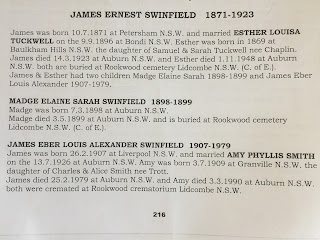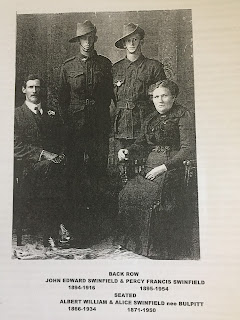 |
| Dorothy and daughter Tracey Jones |

Grave of Ada Louise Swinfield
(1895-1974) in Barton under
Needwood churchyard
William Swinfield had passed away nearly thirty years earlier in 1945 at the age of 74. He had been born on 13th August 1870 at Alrewas as the son of Joseph Swinfield (1843-1905), a farm labourer, and Hannah whose maiden surname had been Riley. His family of five children lived at Alrewas before moving to Barton under Needwood between 1875 and 1881. Joseph was a native of Earl Shilton in Leicestershire being born there in 1843. He was the son of Thomas Brown and Sarah Hewitt, the mother being the estranged wife of Thomas Swinfield, who emigrated to America.
%20Edward%20Swinfield%20(1)%20cropped.jpg)
Grave of (Albert) Edward Swinfield
(1925-1948) at Barton under Needwood
Dorothy’s older brother Albert joined the Navy at the
age of 14. He arrived home in time for her birthday along with her
first ever birthday cake. He was taken prisoner of war at the age of 17. Dot
was very proud of him and often spoke of how brave he had been. Sadly, he never
recovered from his time in Makassar Camp on the island of Java and died in 1948
at the age of only 23.
Dot, as she was known throughout her long life, began working at the age of 14 as a chamber maid at The Silverhill in Birmingham. She then worked at The Yenton Hotel, Midland Journey, Sharps and Knights and at the Oakmore Café. She was a cleaner for John Taylor High School and worked for 15 years at Rangemore School for the Deaf.
It was while working at Sharps and Knights that Dot met and fell in love with Tom Bannister, who was to become her second husband in 1958. They moved to Belvedere Road in Burton-on- Trent. Following the births of their son Paul in 1965 and daughter Tracey in 1968, the family moved back to Barton. Over the years, the family grew with the arrival of grandchildren Emma Louise, Alfie and Tasha. Dot loved and doted on her grandchildren.
Dot retired at 65 but never really stopped working. She played bowls and catered at the club, eventually being made an Honorary Member. She loved other games, playing crib, whist, dominoes and bingo, and enjoyed reading. Her world was shattered when Tom died on 7th of June in 2003.
She continued to enjoy a very active life. Tracey had moved to New Zealand and Dot visited her and the Jones family there on several trips. Dot had a stroke on the 9th of March 2023 and spent the remainder of her life in the Jayson Hylton Nursing Home where she died on 9th March 2024, aged 94. The funeral service took place in her home parish church of Barton under Needwood on 3rd April.







%20-%20done.jpg)






.jpg)
.jpg)

